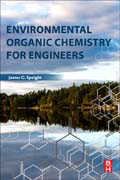
Written for Environmental Engineers, Civil Engineers and researchers, Environmental Organic Chemistry for Engineers clearly defines the principles of environmental organic chemistry and the role they play in forming remediation strategies. In this reference, the author explores parameter estimation methods, the thermodynamics, and kinetic needed to predict the fate, transports, and reactivity of organic compounds in air, water, and soils. Environmental Organic Chemistry for Engineers four part treatment starts with the classification of organic molecules and physical properties of natural organic matter, halocarbons, phenols, polyaromatic hydrocarbons, organophosphates, and surfactants. An overview of remediation technologies is also provided. This is followed by a discussion of the interactions that lead to physical properties that affect chemical distribution in the environment. As well as the important reaction classes of organic molecules including substituent effects and structure and activity relationships found in Parts two and three. Part four is devoted to the different remediation technologies strength and weakness and when they should be employed. Clearly defines the principles of environmental organic chemistry and the role they play in forming remediation strategiesThe tools and methods for classifying environmental contaminants found in air, water, and soilPresent a wide-range of remediation technologies and their when they should be deployed for maximum effect INDICE: Part One: Classification of organic molecules and physical properties Section One: Classification of Organic Molecules and Physical Properties Section Two: Sources: Agrochemicals, Industrial chemicals, Flame retardants, Process by-products Section Three: Organic chemistry and Remediation Technology Part Two: Chemical Distribution in the Environment Section Four: Molecular interactions, physical properties and chemical distribution in the environment Part Three: Chemical Transformations in the Environment Section Five: Reaction classes of organic molecules including substituent effects and structure - activity relationship Section Six: Nucleophilic Reactions Section Seven: Reduction Reactions Section Eight: Oxidation Reactions Part Four: Remediation technologies Section Nine:Thermal desorption Section Ten: Excavation or dredging Section Eleven: SEAR - surfactant enhanced aquifer remediation Section Twelve: Pump and treat Section Thriteen: Solidification and stabilization Section Fourteen: In situ oxidation Section Fifteen: Soil vapor extraction
- ISBN: 978-0-12-804492-6
- Editorial: Butterworth-Heinemann
- Encuadernacion: Rústica
- Páginas: 540
- Fecha Publicación: 01/11/2016
- Nº Volúmenes: 1
- Idioma: Inglés
